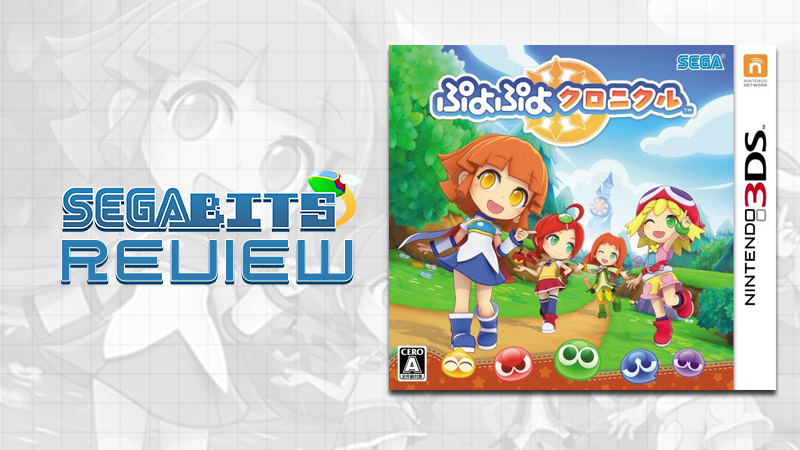
25 years has past by for the Puyo Puyo series (27 if counting Madou Monogatari). Originally the series was conceived as a modest puzzle game in the same vain as Dr. Mario or Tetris on the MSX and Famicom Disk System, before making it big with the arcade games Puyo Puyo and Puyo Puyo Tsu. Even after the demise of Compile at the beginning of the new millennium, SEGA would still keep up the legacy of the franchise with the occasional new game and merchandising. Enough so that Puyo Puyo is considered one of SEGA’s “core” franchises in Japan.
Now that it’s the 25th anniversary of the Puyo Puyo series, naturally a new game would be released to compliment this milestone. However the new game in the series, Puyo Puyo Chronicles, takes a slightly different approach from the norm while at the same time trying to keep things familiar for long time fans. Is it a worthy milestone celebration chronicling the series strengths, or a sign that this chronicle should end?
Presentation
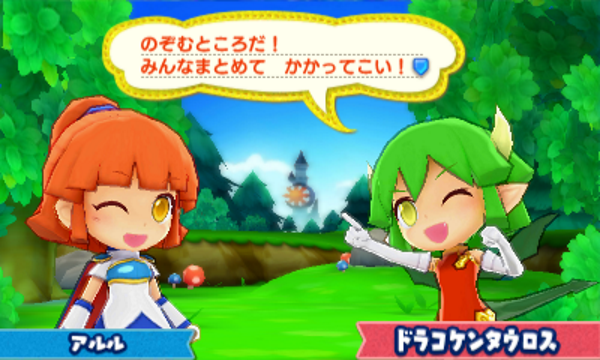
When it comes to presentation, normally Puyo Puyo games by SEGA go for a minimalistic approach. Every character would appear to be a set of pictures animated in a way to give off the illusion of movement. For example, individual body parts such as arms, legs, tails, wings, and so on would be separate images manipulated in a way to express attacking, defending, or being damaged. For the most part, this was fine, and with each installment this concept would be refined further.
Puyo Puyo Chronicles however goes for a different approach by making all the characters models instead of animated sprites/illustrations. While it’s not the first Puyo Puyo game to use models instead of sprites, that honer goes to the rhythm game spin-off Puyo Puyo DA! for the Dreamcast, it’s still a welcome change. The characters still have that familiar colorful charm like past games despite the makeover, and for the most part it manages to dodge the “uncanny valley” problem that occasionally crops up from turning 2D to 3D. Also because models are used instead of still images, it helps the overall animation have more flexibility when it comes to conveying expressions or actions. The designers were probably aware of this, since before battles in the RPG mode the camera will pan around to show off the characters.
However, there are still a few problems, or at least nitpicks. While for the most part the makeover works, some characters like Ocean Prince can look a little strange depending on the angle viewed from. Which is sort of unavoidable when it comes to a visual overhaul like this, since these characters were originally designed to be 2D. Another detail that’s jarring is the framerate. In a Puyo Puyo match it’s played at 60 frames per second, but for some reason animations from the characters are played at 30 frames per second, which is noticeable but at the same time doesn’t ruin the game. There is also a lack of 3D utilized in the whole game.
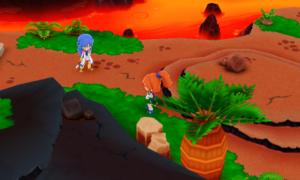 But possibly the most disappointing aspect of the presentation is the RPG mode. Yes the environments are varied and to be fair it still looks nice and colorful, but it kind of suffers from “New Super Mario Bros. syndrome” where the major locations are stereotypical video game settings. There’s the grasslands, there’s the desert, there’s the snow land, etc. Which wouldn’t be a problem if it was handled well, but sometimes it feels like these locations are recycled because of the lack of distinctive landmarks. Despite this, there are some details that are kind of nice, like how the volcanic areas mix in some vegetation to help contrast from the red rocks like with palm trees and patches of grass.
But possibly the most disappointing aspect of the presentation is the RPG mode. Yes the environments are varied and to be fair it still looks nice and colorful, but it kind of suffers from “New Super Mario Bros. syndrome” where the major locations are stereotypical video game settings. There’s the grasslands, there’s the desert, there’s the snow land, etc. Which wouldn’t be a problem if it was handled well, but sometimes it feels like these locations are recycled because of the lack of distinctive landmarks. Despite this, there are some details that are kind of nice, like how the volcanic areas mix in some vegetation to help contrast from the red rocks like with palm trees and patches of grass.
Speaking of which, sadly the towns themselves are nothing special either. You can talk to NPCs to get some world building, but ultimately the NPCs feel like an afterthought, aside from the occasional one that provides a quest. I think the best part about the towns is weirdly the introduction that pans around the town and then name drops the town’s name. That detail reminds me of Xenoblade Chronicles, strangely enough, but it helps try to make the towns feel a bit more “grand”, for a lack of better term. Ultimately though, the towns are these for the sidequests and shops, so if you’re expecting more you’re not going to get it here.
Despite these nitpicks, this overhaul from Puyo Puyo Chronicles is a step up from past games since it feels like an evolution of the presentation. If future titles can improve on it further, it can work pretty good as the new “standard”. If you can ignore these nitpicks, the game still has that signature cute and colorful presentation fans of the series are accustomed to.
Gameplay
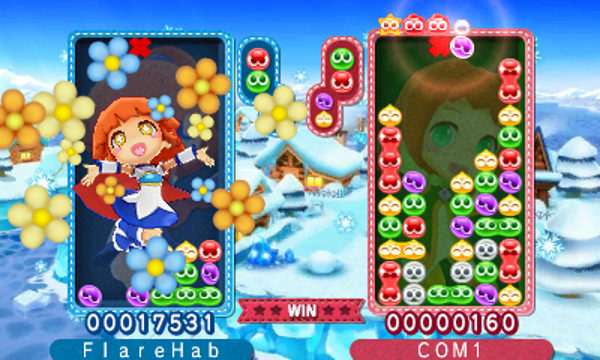
In a sense this game can be divided by two parts, the single player RPG mode and the 18 different multiplayer modes. Both are their own section, the only connection being that playing through the RPG mode unlocks more characters that can used in multiplayer.
RPG mode
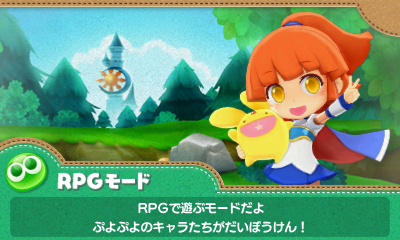 The RPG mode as the name suggests is a single player experience styled like an RPG. In a sense the game is SEGA’s answer to the Puzzles & Dragons spin-off Puzzles & Dragons Z for the 3DS, in that it’s adapting RPG elements into a puzzle title. However, it’s also a spiritual successor to the game Puyo Puyo BOX, specifically a similar Quest mode where you played as Arle traveling across the land and collecting medals using some RPG elements like experience and equipment.
The RPG mode as the name suggests is a single player experience styled like an RPG. In a sense the game is SEGA’s answer to the Puzzles & Dragons spin-off Puzzles & Dragons Z for the 3DS, in that it’s adapting RPG elements into a puzzle title. However, it’s also a spiritual successor to the game Puyo Puyo BOX, specifically a similar Quest mode where you played as Arle traveling across the land and collecting medals using some RPG elements like experience and equipment.
The general plot is that recurring protagonist Arle Nadja gets sucked into another world by a mysterious book, and she gets help from a new character named Ally. Along the way, the player as Arle starts to encounter other familiar faces that similarly got sucked into Ally’s world. Along the way, Arle and company start shattering mysterious crystal balls scattered throughout the land and freeing the stars trapped inside from 5 major locations. While the premise is simple, there is a plot twist in the game that won’t be spoiled here (Sorry!). It’s a Puyo Puyo game so naturally it’s not going to have a deep plot, but if you enjoy the interactions between your favorite characters, you may still get have a good time regardless.
Puyo Puyo Chronicles’ interpretation of the formula is similar to Puyo Puyo BOX, but it features several key differences. The major one is that throughout the adventure, you can recruit different characters. You can recruit up to 29 characters, 24 of the normal characters and a bonus 5 characters that are exclusive to the RPG mode and Skill Battle mode. Each character comes with their own characteristics, and the player can use a maximum of 3 characters in a party, further flexible by the ability to create up to 5 separate parties. However keep in mind some characters are optional recruits that need a specific side quest to encounter, so you may miss out on characters on your first playthrough. It’s even possible to recruit the enemies, though the enemies are lackluster compared to the Puyo Puyo characters you recruit as you go through the mode.
Like other RPGs, there are sidequests that are requested by the towns folk. These are important if you plan on completing the game 100%, but at the same time they are completely optional. All you need to do is ask specific NPCs with a scroll icon above their head, and accept their request. Once you accept their request, either a new area will be unlocked to explore or a previous area will be updated. Sometimes it’s obvious, like the map may have added treasure chests or shiny spots. Other times it’s more ambiguous, where you may have to do some careful area scanning. For those that can’t speak Japanese, this is where the “language barrier” problem is going to be the most prevalent, since if you don’t know where to go or what to do, you’ll get lost. The main reward for completing these quests is money or equipment, but again occasionally these quests can lead you to the optional party members, like for example one sidequest leading you to Harpy.
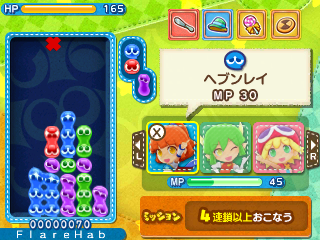 Every character is assigned a color, between red, blue, green, yellow, and purple, and each individual character has their own stats that gets accumulated for the whole party. Every character also has two types of Skills, an Auto Skill that acts as a passive effect and a Special Skill that has a direct effect by pressing the X button. The colors and the Skills reflect the effect, for example a character classified as blue like Arle will produce blue Puyo on the bottom two rows. Colors can effect the match up against enemies, since it’s possible for both the player and enemy to inflict buffs or debuffs for a specific color. However as a form of balance, using a Special Skill requires enough mana points in order to execute, with the amount varying between Skills.
Every character is assigned a color, between red, blue, green, yellow, and purple, and each individual character has their own stats that gets accumulated for the whole party. Every character also has two types of Skills, an Auto Skill that acts as a passive effect and a Special Skill that has a direct effect by pressing the X button. The colors and the Skills reflect the effect, for example a character classified as blue like Arle will produce blue Puyo on the bottom two rows. Colors can effect the match up against enemies, since it’s possible for both the player and enemy to inflict buffs or debuffs for a specific color. However as a form of balance, using a Special Skill requires enough mana points in order to execute, with the amount varying between Skills.
On top all this, there’s equipment you can either purchase from shops, get from completing quests, or occasionally get from defeating an enemy. Each color effects a specific stat, red effects attack, blue effects defense, green effects mana points, yellow effects hit points, and purple effects luck. It’s also possible to merge these equipment together to make them have a stronger effect. Later equipment you can get even boosts multiple stats.
All this is, naturally, tailored towards the battles. Enemies run around the map as you travel around, each enemy type moving in different ways and having their own abilities. For example, one of the enemy types called a Wheeloo has the ability to raise their defense by 25% against a specific color. For those that are familiar with Nintendo’s Earthbound, enemies similarly can be approached in different ways and can provide advantages or disadvantages depending on their position. If you strike an enemy normally, there will be no effect. However if you strike an enemy from behind, the preset chain you have will be slightly extended. Conversely, if an enemy attacks you from behind, they will inflict damage at the start of the battle. Also similar to Earthbound, if you’re strong enough, enemies will instead run away and you may even be able to knock them out without entering battle.
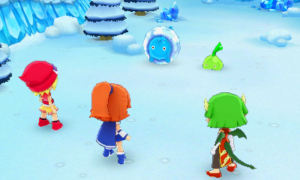 When you do start a match, you’re pitted against the enemy. Given a preset chain to toy with, the objective is to knock out the enemy by inflicting enough damage with chains. If there are multiple enemies, you can specifically choose one by pressing the Y button, but any leftover damage will flow over to an adjacent enemy. As previously mentioned, enemies can be effected by color, being strong or weak against certain ones depending on the circumstances. However, enemies can fight back. Not only will enemies inflict damage, but they will also drop some Nuisance Puyo onto the player’s field. Also depending on the type of enemy you face, they may inflict their own Skills that can hinder you.
When you do start a match, you’re pitted against the enemy. Given a preset chain to toy with, the objective is to knock out the enemy by inflicting enough damage with chains. If there are multiple enemies, you can specifically choose one by pressing the Y button, but any leftover damage will flow over to an adjacent enemy. As previously mentioned, enemies can be effected by color, being strong or weak against certain ones depending on the circumstances. However, enemies can fight back. Not only will enemies inflict damage, but they will also drop some Nuisance Puyo onto the player’s field. Also depending on the type of enemy you face, they may inflict their own Skills that can hinder you.
So based on all this, it sounds like the RPG mode has some surprising complexity. Unfortunately, the RPG mode’s greatest flaw is redundancy. The attempts at adding strategy to these battles is ultimately contradictory to the nature of Puyo Puyo, since it’s perfectly possible to plow through these enemies by just hitting them with a large enough chain. If you’re skilled enough, there’s not a point where you have to worry about details such as color advantage or utilizing the Skills at the right time. The only time where you may consider these strategies is for the occasional boss battle with one of the Puyo Puyo characters, and that’s still a bit of a stretch. In fact you don’t even have to worry about prolonged effects since your health and mana is automatically restored after every fight, and EXP is generous enough that you don’t need to grind either, occasionally causing you to dodge enemies rather than engage in combat. This problem sadly contributes to the overall “bare” feeling the RPG mode provides.
For what the RPG mode is, it feels more like a distraction than a full experience. The closest comparison is with the game Final Fantasy Mystic Quest, in that it tries to be “basic” in order to be accessible, but it’s so bare that any attempts at strategy is ultimately redundant as you can just brute force your way through things. Basically, all you have to worry about is getting strong enough equipment and repeatedly beating your enemies with repetitive chaining. However, inexperienced people may find the mode being easy to be a positive, so in a sense it’s up to preference. But for those that are savvy with playing Puyo Puyo, you may be disappointed with how it doesn’t hold up.
Multiplayer
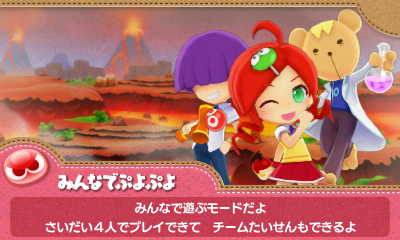 Puyo Puyo Chronicles has a lot of multiplayer modes to choose from. 18 to be exact total, however several need to be bought using points accumulated from playing these modes. The overall package comes with modes based on Puyo Puyo, Puyo Puyo Tsu, Puyo Puyo Sun, and Puyo Puyo Fever, several returning modes from Puyo Puyo! 15th Anniversary and Puyo Puyo!! 20th Anniversary, Big Bang from Puyo Puyo Tetris, and the brand new Skill Battle mode based on the RPG mode.
Puyo Puyo Chronicles has a lot of multiplayer modes to choose from. 18 to be exact total, however several need to be bought using points accumulated from playing these modes. The overall package comes with modes based on Puyo Puyo, Puyo Puyo Tsu, Puyo Puyo Sun, and Puyo Puyo Fever, several returning modes from Puyo Puyo! 15th Anniversary and Puyo Puyo!! 20th Anniversary, Big Bang from Puyo Puyo Tetris, and the brand new Skill Battle mode based on the RPG mode.
This is probably where you’re going to spend most of your time, as typical with a Puyo Puyo game. Which is not a bad thing at all, since Puyo Puyo always excelled as a multiplayer title. Luckily, because of the versatility of the modes, there’s bound to be a favorite mode you’ll sink your time into.
In most modes, you have a selection of 24 characters, the exception being Battle Skill which includes the bonus 5 characters from the RPG mode. Depending on the mode, characters function differently. In some modes, the characters are purely cosmetic, for example in the Puyo Puyo Tsu mode. In other modes, the characters have influence on the gameplay, such as utilizing character-specific dropsets in Puyo Puyo Fever or the Skills in Battle Skill. So for example if you’re playing the Puyo Puyo Fever mode, you might pick a character with a small dropset like Arle for precision or a character with a large dropset like Carbuncle to quickly fill the board. It’s also worth noting that every character has their own AI and will behave differently between each one. For example a character like Draco will have weak AI, while a character like Ms. Accord will have strong AI. Some characters like Suketoudara and Yu & Rei in particular will set up in a specific pattern, in this case filling the first 4 rows with Puyo and filling the 1st and 6th columns respectively.
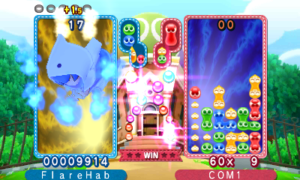 Naturally since there’s a lot of modes, some modes are going to be better then others. Personally speaking, I find modes like Quartet, Blocks, and Foursight to be among the weaker modes available, and to an extent I find Endless Fever to be a bit redundant with Big Bang being the better handled mode. Meanwhile, modes like Excavation and the already mentioned Big Bang are fun modes, along with the more traditional ones like Puyo Puyo Tsu and Puyo Puyo Fever. But this is personal preference, what you like may differ due the nature of having a lot modes. It’s also possible to adjust settings on any of these modes if you want to “improve” a mode or add a quirky spin on things.
Naturally since there’s a lot of modes, some modes are going to be better then others. Personally speaking, I find modes like Quartet, Blocks, and Foursight to be among the weaker modes available, and to an extent I find Endless Fever to be a bit redundant with Big Bang being the better handled mode. Meanwhile, modes like Excavation and the already mentioned Big Bang are fun modes, along with the more traditional ones like Puyo Puyo Tsu and Puyo Puyo Fever. But this is personal preference, what you like may differ due the nature of having a lot modes. It’s also possible to adjust settings on any of these modes if you want to “improve” a mode or add a quirky spin on things.
There are three types of multiplayer available. A mode where you play against a CPU opponent, represented by the yellow Puyo on the main menu. In that mode, you have the option to either have a standard match against an opponent, or engage in one of the endless modes. A mode where you play against an opponent locally, represented by the red Puyo. Finally, a mode where you can connect to the internet where you can face off against players around the world or download additional content, represented by the blue Puyo. However, a disappointing aspect about online play is that only 3 of the 18 modes are available, Puyo Puyo Tsu, Puyo Puyo Fever, and the Skill Battle mode. Sorry, no online Mini Excavation!
Aside from playing against CPUs and humans, these multiplayer modes are also how you accumulate points. Every match rewards you with a small amount of points, even if you lose (albeit only getting 1 point). These points act as a currency in a shop that allows you to unlock additional content. This includes Puyo skins, alternative voices that change how specific characters talk during a match, and unlocking more game modes.
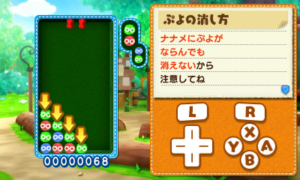 Finally the last thing to address, though not technically “multiplayer”, is a lesson mode that provides insight as to how Puyo Puyo works. This includes the basics such as how to rotate and manual drop, to more complicated concepts such as how to build specific types of chains, and mode specific mechanics such as how Sun Puyo and Fever work. If you’re just starting to play Puyo Puyo and want to know how the game works, I’d recommend looking into the tutorials and then practicing at your own pace.
Finally the last thing to address, though not technically “multiplayer”, is a lesson mode that provides insight as to how Puyo Puyo works. This includes the basics such as how to rotate and manual drop, to more complicated concepts such as how to build specific types of chains, and mode specific mechanics such as how Sun Puyo and Fever work. If you’re just starting to play Puyo Puyo and want to know how the game works, I’d recommend looking into the tutorials and then practicing at your own pace.
Overall, despite how advertisements somewhat ignored this aspect, it’s arguably the stronger side if you’re into the franchise’s signature multiplayer. The main gripes being the limited options for online play, and for veteran Puyo Puyo players the lack of “new” modes compared to past Anniversary titles could be off putting. But a type of game like Puyo Puyo Chronicles is perfect if you want to sink time on a handheld system like the 3DS, just like past titles.
Conclusion
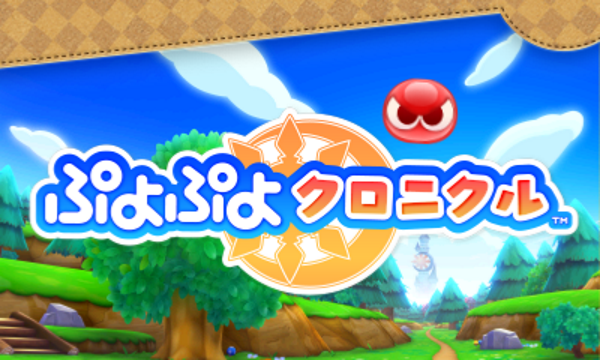
It’s kind of hard to say where Puyo Puyo Chronicles lands. On one hand, the game stays true to the franchise’s strengths like having a strong multiplayer and having a cast of quirky colorful characters, while at the same time updating the presentation. However on the other hand, the new ideas implemented like the RPG mode feel like they were not thoroughly thought out and it sort of invokes an empty feeling. For veterans of the Puyo Puyo series, you may not get much mileage if you don’t enjoy the main attraction of the RPG mode, since most of the multiplayer modes are recycled from past titles. On the other hand, this can be a great introduction for those that want to get into the series or at least want a handheld game to sink their time into, due to it’s surprising versatility. Ultimately though, Puyo Puyo Chronicles is still one those sort of games where there’s at least something for everyone.
It’s also worth stressing that if you do decide to import Puyo Puyo Chronicles, remember that unlike Puyo Puyo Tetris the game has region locking due to being exclusive to the 3DS. Before importing, make sure you have some type of method to play this game, whether officially or not. Whether or not this game will get a localization by SEGA/Atlus as a compromise is up to them, but until then do your research before taking action.
Positive:
- Still cute and colorful as ever, the updated presentation helping “evolve” it.
- Multiplayer is still a blast, like usual.
- Lot’s of content, especially with multiplayer.
- It has an ambitious (at least for the series) RPG mode.
Negative:
- Not a lot of “new” multiplayer options
- Online multiplayer is limited
- The RPG mode has “redundancy/repetition” issues that hinder the overall experience.
- There’s some minor presentation problems/nitpicks.
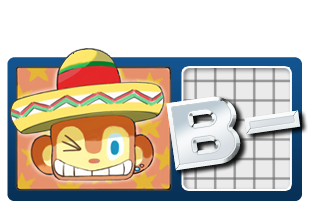 “While the RPG mode is flawed, the game still holds up with Puyo Puyo’s signature multiplayer and general flexibility in terms of content.”
“While the RPG mode is flawed, the game still holds up with Puyo Puyo’s signature multiplayer and general flexibility in terms of content.”



I’m just wondering, for local Multiplayer, do all players need a copy of the game in order to play?
Unfortunately, I couldn’t test local multiplayer since I had no one else to play with. I did try out online and it does work fine. There is the occasional lag spike and disconnect, but nothing deal breaking, and it works fine otherwise.
RE:Review: Puyo Puyo Chronicles (3DS) – SEGAbits Валок Lemken Мытищи